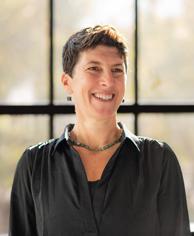Q&A: MIT as an International Model for Sustainability
Julie Newman, PhD, Director of Sustainability

Fast Forward: MIT’s Climate Action Plan for the Decade, which launched in May 2021, charged MIT to eliminate its direct carbon emissions by 2050 with an interim goal of net-zero emissions by 2026. The MIT Office of Sustainability (MITOS) is central to this goal in its mission to transform MIT into a replicable model for responding to the unprecedented challenges of a changing planet. Julie Newman, founding director of MITOS, came to MIT in 2013 after founding a similar office at Yale University, and also serves as a lecturer in the Department of Urban Studies and Planning.
Climate is one of MIT’s top priorities. How does MITOS fit into that landscape?
MITOS is a catalyzer of the climate work happening on campus and the organizational leader for MIT’s campus climate commitments. Engaging with faculty and staff, we take a collaborative, systems-based approach to ensure the resiliency of MIT, positioning the entire campus as a test bed for sustainability and climate solutions. We consider the role of the individual to the campus, to the city, to the state, to the nation, to the globe. All of our work around sustainability and climate runs through those lenses, as we facilitate the implementation of solutions and measure impact.
How does MITOS work with students and MIT researchers?
MITOS presents a well of opportunity for students, from engineers to entrepreneurs, to work on real-time issues in an educational environment. We’re the connective tissue that pairs researchers to the appropriate operational groups to implement their work on campus. Our Sustainability DataPool—the first of its kind—puts MIT-specific data in the hands of our community to help them better understand and recognize the value proposition of local data in catalyzing innovative thinking and solution development. We also employ a student research cohort each semester and have made grants from our Campus Sustainability Incubator Fund, which funds the innovative projects of MIT community members.
What are some examples of MITOS’s work at a local and global level?
Climate resiliency efforts led by our staff with Campus Planning, Facilities, and student researchers have informed our decarbonization plans that are in design and, when finalized and financed, will seek to be implemented between now and through 2050. The climate resiliency student and operational research work we’ve completed has led to many interventions on campus. In the new MIT Stephen A. Schwarzman College of Computing building and other new construction, our work has informed numerous efforts, such as additional flood protections and sustainably sourced building materials. Last year, our work led to the installation of new solar panels on four MIT buildings. Even our office space in Building E38 is a living lab for innovative design and sustainable materials that are then applied to future design across campus. These interventions translate to our goal of transforming MIT into a replicable model for sustainability for other institutions across the United States and around the world. I’ve consulted with universities on almost every continent, and in recent years, MITOS has regularly invited scholars to apply to spend two weeks learning from us and exchanging ideas so we can learn from each other. That exchange has been remarkable.
What role does philanthropy play at MITOS, particularly with planned gifts?
When we think about how to plan for and meet our climate and sustainability goals over the next 100 years, we are considering long-term investments. A donor’s commitment through a bequest or other type of planned gift is fundamental to our ability to study, design, and implement solutions. Simultaneously, there is an urgent need for outright gifts to support our work on campus, where we have access to the relationships, expertise, and capability to try new approaches. We see this work as our responsibility to our students, and are fortunate to have an opportunity to think locally to understand those implications at the global level.
